Theosophical Symbols
From William Q. Judge Theosophical Articles, Vol. I.
THE first article printed in the PATH on this subject was “Theosophical Symbolism” in Vol. I, May 1886.
The symbols of the Society are contained in its seal, which may be described first. It consists of a serpent formed into a circle and biting or swallowing its tail. Placed within this circle are two interlaced triangles that make what is called the “Seal of Solomon,” one of the triangles pointing apex up is white in color or any shade that is equivalent to that when compared with the other triangle, which is dark, as it should always be so represented. On the serpent and near its head so as to be in the centre line of the circle is a small circle within which is 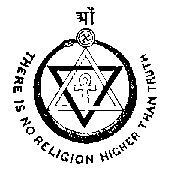 inscribed the Swastica, a simple cross with its four ends turned backward. Inside the central space enclosed by the two interlaced triangles is placed the famous cross of the Egyptians called ansata, and which is many times older than the Christian symbol. It is a cross without a top arm, which is replaced by an oval the narrow end of which rests on the top of the cross, thus forming its top arm. It should be of a white color. Around the whole is written the motto of the Society, reading “There is no religion higher than Truth,” the family motto of the Maharajahs, or great kings, of Benares, the sacred city of India. Sometimes over the top of the seal is written “OM,” the sacred word of the Hindus and the first letter of the Sanskrit alphabet.
inscribed the Swastica, a simple cross with its four ends turned backward. Inside the central space enclosed by the two interlaced triangles is placed the famous cross of the Egyptians called ansata, and which is many times older than the Christian symbol. It is a cross without a top arm, which is replaced by an oval the narrow end of which rests on the top of the cross, thus forming its top arm. It should be of a white color. Around the whole is written the motto of the Society, reading “There is no religion higher than Truth,” the family motto of the Maharajahs, or great kings, of Benares, the sacred city of India. Sometimes over the top of the seal is written “OM,” the sacred word of the Hindus and the first letter of the Sanskrit alphabet.
It will be of interest to all members of the Society to know that, although some people have claimed to be the inventors of this seal as just described and that they made it for the Society in its initial stages in 1875, Madame Blavatsky long before then and before these claimants heard of Theosophy used substantially the same thing in her private note paper, some samples of which are in my desk, as also the original block from which she had her paper printed. Her seal had the coronet of countess over the top, and her monogram in the middle in place of the Egyptian cross. Some years after the adoption of the seal by the Society a person by the name of Bothell of Bath, England, made a hybrid imitation of it by splitting the serpent into three as if to show that evolution had divided itself up into heterogeneous elements, and he was them imitated by a person in America who sold amulets and love philters, meanwhile cribbing wholesale from all the Theosophical books and periodicals in order to make a saleable book on the darkness of Egypt. These childish imitations sufficiently expose themselves to anyone who knows something of symbology.
Our seal points the mind to the regenerated man, who, symbolized by the cross, stands in the centre enclosed by the light and dark triangle, and encircled by the great serpent or dragon of evolution and matter. But an analysis of the different parts of the whole will aid us in understanding and grasping all its meanings. For in symbology the symbol is only right when it fitly represents all the ideas meant to be conveyed, and in all its parts is consistent with the whole, as well as being also in conformity to tradition and the rules of the ancients. It should also when understood be of such a character that when it is looked at or thought of, with the image of it in mind, all the ideas and doctrines it represents recur to the thinker. This is why confused symbols are useless and right one of the greatest use. Indeed, the same rule holds with clairvoyance-a very different subject- for there the symbol which is the image of the person or thing desired to be seen clairvoyantly may confuse the seer, or the opposite, just as it is or is not consistent. Symbols are also valuable for the older reason that, while the books, the writings, and other works of men fade away and are no more for subsequent ages, the great symbols do not disappear. Our Zodiac is one mass of these, and though its age is a mystery it still lingers in our almanacs and figures in the sacred books or monuments of all times and peoples. And even today the most materialistic of our people are wondering if it may not be possible to communicate with the inhabitants of other planets by the use of symbols, in some such way as the savage may be dealt with by the use of sign language.
Let us take the serpent which forms the great circle of the seal. Swallowing its tail, 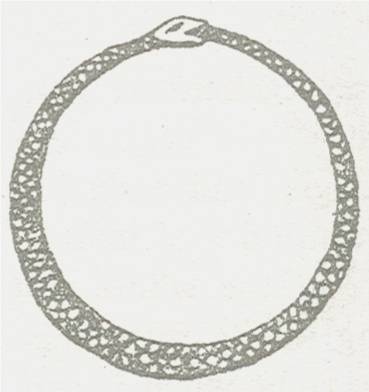 it shows the cycle of eternity or the great spiral of evolution or the Manvantara. This is the circle of necessity of the Egyptians, the path of the numerous incarnations of the soul. Merely even as serpent it signifies this, for the serpent casts its skin periodically just as man does at every death of his many bodies. It also signifies wisdom, as the Serpent has been called the wise, and, as shown in the Secret Doctrine, the word also meant the Masters of wisdom and power. Its tail running into its mouth means perpetual turning of the circle, or the periodical coming forth and disappearing of the manifested Universe. Nearly every bible has this. Saint John speaks of the great dragon who swept with his tail one-third of the stars to the earth. That is, that in the course of this great evolution the serpent we are considering brought egos from the stars down to this globe, or up to it if you prefer and think it any better than the others in the sky. In the form of a circle it symbolizes perfection, as that is the most perfect figure, which, too, in its different relations shows us the great doctrine that the Universe was built by number, weight, and number, and is controlled or presided over by harmony now disturbed and now restored.
it shows the cycle of eternity or the great spiral of evolution or the Manvantara. This is the circle of necessity of the Egyptians, the path of the numerous incarnations of the soul. Merely even as serpent it signifies this, for the serpent casts its skin periodically just as man does at every death of his many bodies. It also signifies wisdom, as the Serpent has been called the wise, and, as shown in the Secret Doctrine, the word also meant the Masters of wisdom and power. Its tail running into its mouth means perpetual turning of the circle, or the periodical coming forth and disappearing of the manifested Universe. Nearly every bible has this. Saint John speaks of the great dragon who swept with his tail one-third of the stars to the earth. That is, that in the course of this great evolution the serpent we are considering brought egos from the stars down to this globe, or up to it if you prefer and think it any better than the others in the sky. In the form of a circle it symbolizes perfection, as that is the most perfect figure, which, too, in its different relations shows us the great doctrine that the Universe was built by number, weight, and number, and is controlled or presided over by harmony now disturbed and now restored.
For, although the proportion of the diameter of the circle is as one to three, there is a remainder, when we are exact, of figures that cannot be written because we never should get to the end of them. This is the unknown quantity continually entering into the succession of events and ever tending to restore the harmony.
The two interlaced triangles come next in importance. This is the “Seal of Solomon,” so called because it was popularly supposed he used it when dealing with the genii that did his bidding. Among the Moors is a tale of how he confined one of the spirits in the Red Sea in a pot, on the top of which this seal was inscribed. But this is 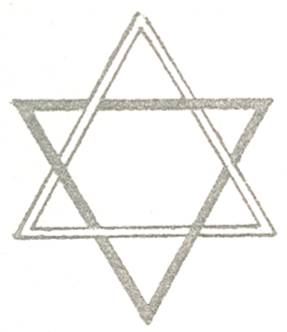 hardly the origin of it. On a very ancient Indian coin in my possession may be seen the same seal surrounded by rays of the sun, and the figure was known in the early ages in Hindustan. A couple of Brahim friends of the writer state that it has always been known in that caste. In Isis Unveiled, page 266, H.P. Blavatsky has a very good exposition of it, accompanied with two diagrams illustrating its Hindu and Jewish forms. These triangles also symbolize the sevenfold constitution of man and all things. They have six points and six triangles enclosing a central space which is the seventh division of them and here represents the seventh principle of more properly the thinker, standing in the universe and touching all things from the six sides by means of the six triangles. The points of these touch the sides of the serpent or the great encircling wheel of evolution in and by which the thinker gains experience from nature. The white triangle -called the upper-refers to spirit, and the lower, or dark one, to matter; interlaced they signify, as said in the Bhagavat-Gita, that spirit and matter are coeternal and ever conjoined. Thus they also represent, the great opposites in nature and mind of good and evil, night and day, male and female, liberty and slavery, cold and heat, those great contrasts by means of which we are able at last to find the truth. In the Kaballah this figure is thought much of. Thus it is said that its representation in this world is a reflection or the reverse of the real triangle in the upper worlds. But this statement does not convey much, because, if one tries the experience of reversing the image on paper, it will be found that when our figure would have the black triangle uppermost, and in mystical writings that means the reign of black magic. Probably that is what the Cabalists meant, as they delight in calling this the dark world or hell.
hardly the origin of it. On a very ancient Indian coin in my possession may be seen the same seal surrounded by rays of the sun, and the figure was known in the early ages in Hindustan. A couple of Brahim friends of the writer state that it has always been known in that caste. In Isis Unveiled, page 266, H.P. Blavatsky has a very good exposition of it, accompanied with two diagrams illustrating its Hindu and Jewish forms. These triangles also symbolize the sevenfold constitution of man and all things. They have six points and six triangles enclosing a central space which is the seventh division of them and here represents the seventh principle of more properly the thinker, standing in the universe and touching all things from the six sides by means of the six triangles. The points of these touch the sides of the serpent or the great encircling wheel of evolution in and by which the thinker gains experience from nature. The white triangle -called the upper-refers to spirit, and the lower, or dark one, to matter; interlaced they signify, as said in the Bhagavat-Gita, that spirit and matter are coeternal and ever conjoined. Thus they also represent, the great opposites in nature and mind of good and evil, night and day, male and female, liberty and slavery, cold and heat, those great contrasts by means of which we are able at last to find the truth. In the Kaballah this figure is thought much of. Thus it is said that its representation in this world is a reflection or the reverse of the real triangle in the upper worlds. But this statement does not convey much, because, if one tries the experience of reversing the image on paper, it will be found that when our figure would have the black triangle uppermost, and in mystical writings that means the reign of black magic. Probably that is what the Cabalists meant, as they delight in calling this the dark world or hell.
The thirty-third degree of Freemasonry may also be obtained from this figure. That degree is the Consistory or Council, emblematically the great body of the Sages or Governors, the collection or sum of all the others. The idea now illustrated may be new to Freemasons, but is nevertheless correct. 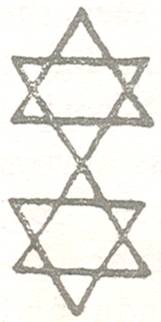 Revolve the figure downwards so as to produce a reverse image, and we get two; as the Kaballah of the Jews has it, one the image of the other. Next take the two slanting sides, being the prolongation of the two downward-pointing sides of the upper dark triangle, and make a reflection upon them as base on each side.
Revolve the figure downwards so as to produce a reverse image, and we get two; as the Kaballah of the Jews has it, one the image of the other. Next take the two slanting sides, being the prolongation of the two downward-pointing sides of the upper dark triangle, and make a reflection upon them as base on each side. 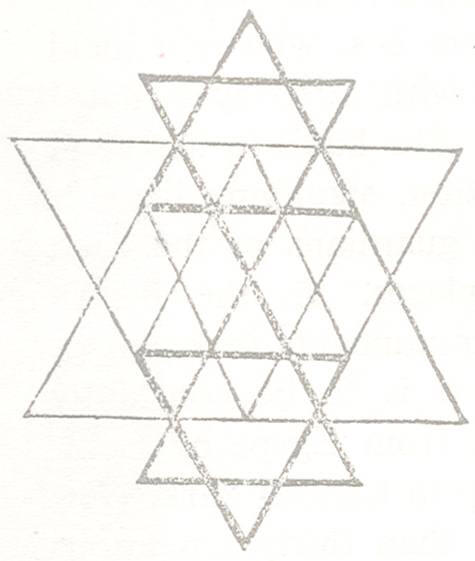 The result will be the figure here shown, in which three smaller “Salomon’s seals” are contained within the greater one. If now the chambers or divisions in this new figure are counted, they will be found to number thirty-two, and by adding the figure as a whole we get thirty-three or the Consistory, which may be placed in the point in the centre of all. This may seem to be fanciful to some, but it is no more so than much else in Masonry. It has the advantage, however, of being correct, even if curious. This number of divisions or chambers, with the whole figure, also gives the number of the thirty-three crores of gods or forces of nature in the ancient Hindu Pantheon.
The result will be the figure here shown, in which three smaller “Salomon’s seals” are contained within the greater one. If now the chambers or divisions in this new figure are counted, they will be found to number thirty-two, and by adding the figure as a whole we get thirty-three or the Consistory, which may be placed in the point in the centre of all. This may seem to be fanciful to some, but it is no more so than much else in Masonry. It has the advantage, however, of being correct, even if curious. This number of divisions or chambers, with the whole figure, also gives the number of the thirty-three crores of gods or forces of nature in the ancient Hindu Pantheon.
No less ancient and interesting than the triangles is the Egyptian cross placed in the very centre of the seal within the six-sided chamber made by the interlaced triangles. This should be a glittering white 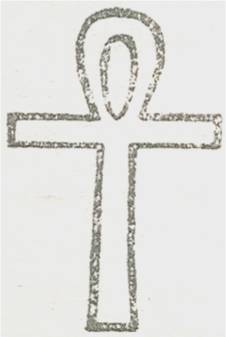 in color, as it represents the regenerated man as well as life. The top oval is matter, and the lower arms spirit, which joined to matter is life both material and eternal. It is also the sign of Venus. And Venus is the elder sister of the earth according to the Secret Doctrine. On Venus are felt our changes, and those proceeding on her affect us. This cross is found in nearly every Egyptian papyrus. The Book of Job is really a translation, somewhat altered, of the Book of the Dead used by the Egyptians. In this the soul-or the candidate-enters the Hall of Two Truths to be judged before Osiris. He is Job. Entering he stands before Isis, who is a maid and says, “I made a covenant with mine eyes that I should not look upon a maid.” She holds in her hand the symbol given in the illustration, signifying life. It was placed in the hands of the guardians of the dead and in many different other places. In the British Museum in the papyri, and on monuments in Egypt or those in Europe and America, it is to be constantly found. On the obelisk brought from Egypt by Commander Gorringe and now set up in Central Park, New York City, a count shows more than thirty repetitions of this symbol. Examining a mummy-case that by some chance was exhibited in Tacoma, Washington, last year, I saw many of these painted on the case. It is one of the most ancients of all the symbols.
in color, as it represents the regenerated man as well as life. The top oval is matter, and the lower arms spirit, which joined to matter is life both material and eternal. It is also the sign of Venus. And Venus is the elder sister of the earth according to the Secret Doctrine. On Venus are felt our changes, and those proceeding on her affect us. This cross is found in nearly every Egyptian papyrus. The Book of Job is really a translation, somewhat altered, of the Book of the Dead used by the Egyptians. In this the soul-or the candidate-enters the Hall of Two Truths to be judged before Osiris. He is Job. Entering he stands before Isis, who is a maid and says, “I made a covenant with mine eyes that I should not look upon a maid.” She holds in her hand the symbol given in the illustration, signifying life. It was placed in the hands of the guardians of the dead and in many different other places. In the British Museum in the papyri, and on monuments in Egypt or those in Europe and America, it is to be constantly found. On the obelisk brought from Egypt by Commander Gorringe and now set up in Central Park, New York City, a count shows more than thirty repetitions of this symbol. Examining a mummy-case that by some chance was exhibited in Tacoma, Washington, last year, I saw many of these painted on the case. It is one of the most ancients of all the symbols.
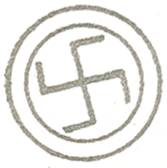
The bent cross in the little circle placed on the serpent at the top of the seal joined to the apex of the upper triangle is the Swastica. It is found almost everywhere in the East, as well as among the earlier Christians an elsewhere in Europe. Many meanings have been given to this; sometimes it represents the whirling of the will, and again the “Wheel of the Law” mentioned in both Buddhistic and Brahmanical books. The Buddhas are said to give the Wheel of the Law another turn when they come, and Krishna tells Arjuna that he who does not keep properly revolving the great wheel of action and reaction between the two worlds lives a life of sin without purpose. in India Swastica represents the spot or center in which the forces from the great unknown pour to show themselves subsequently in various manifestations; and also it stands as a representation of the great mill of the Gods, in the center of which the soul sits, and where all things are drawn in by the turning of the axle to be crushed, amalgamated, and transformed again and again.
This ends an analysis of the seal of the Society. In 1875 the writer of this at request of Col. Olcott drew a design for a pin for the use of members which was then made first by a Maiden Lane jeweler. It is formed by combining the serpent with the Egyptian tau so as to make “T.S.” The illustration shows it taken from a cut made from the old design last year, when the pins began to be used more than previously. They are now worn by a good many members in both America and Europe. Col. Olcott has one that was presented to him just before last London convention by a New York Theosophist.
The Sanskrit “Aum” at the top of the seal and the motto are later additions, adopted after Madame Blavatsky and Col. Olcott went to India. The Aum in its present position is to be read as the “Fountain of Light, the Sun which illuminates our minds, and the goal of our endeavor”-that is truth, for Theosophy constantly proves to us that “There is no religion higher than Truth.”
William Q. Judge,
Path, April 1892

